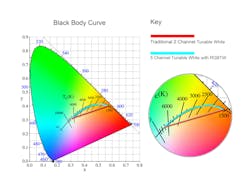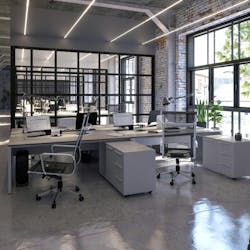The pandemic has definitely changed how we think about office space, remote or hybrid working arrangements, and employee workplace needs. While many office positions have allowed for remote work since 2020, more workers are now being asked to return on-site. To entice employees back to the office, building owners and company facility managers have implemented strategies to improve indoor air quality and overall interior environments. However, lighting is also a significant consideration because it affects people’s productivity, health, and general well-being in any setting.
In 2017, the American Society of Interior Designers, in partnership with Cornell University, Delos, and the Innovative Workplace Institute, researched the impact of workplace design on behavior and performance; the impact of spatial design on organizational goals; and the impact of design on human, organizational, and environmental sustainability. The study found that 68% of employees were dissatisfied with the lighting situation in their offices — ample room for improvement.
Today, tunable white lights offer a reliable technology that can help create an environment that supports alertness and productivity by helping workers maintain their natural circadian rhythm (Photo 1 and Photo 2).
Advancements in tunable white light technology
Tunable white or Kelvin-changing LED lighting allows for the adjustment of correlated color temperature (CCT) and/or the brightness of a fixture or source. Tunable white LED lighting combines the output of multiple diodes — typically a warm white LED and a cool white LED with a linear cross-fade, or blend, between them forming the basis for the light source’s tunable white color spectrum. Example spectrums might range from 2000K to 4000K and 2000K to 6500K.
Naturally occurring white light from the sun promotes alertness and focus; it also follows the blackbody curve. Although conventional two-channel, linear tunable white allows for color temperatures that mimic natural sunlight, it does not follow this curve, which would enable a wider spectrum of tunable white tones. Instead, it can only produce accurate white light at the base points — or color temperatures — at the ends of the given spectrum because no other light sources (RGB) influence the spectrum. The behavior of the color profile is linear rather than a parabolic curve as is seen in the blackbody curve in the Figure.
Researchers at the Interdepartmental Neuroscience program at Northwestern University in Evanston, Ill. found that individuals in work environments with windows received 173% more white light exposure during work hours and slept an average of 46 minutes more per night than those working in windowless environments. This suggests illumination that mimics the sun — which electric light once could not accomplish without modern advancements in tunable white light — delivers better-quality light.
Benefits of human-centric lighting
A 2013 study of human-centric lighting in five government office buildings by the Rensselaer Polytechnic Institute’s Lighting Research Center found that employees working under human-centric tunable lighting had better sleep and lower levels of depression and stress than those who didn’t. Additional studies have shown the impact of light’s spectral content and intensity on circadian rhythm. For example, too much blue light at night can undermine sleep, while playing a stimulating role during the day.
In 2016, property company CBRE Netherlands along with the University of Twente, VU Amsterdam, installed time-controlled, Kelvin-changing lighting at CBRE’s Amsterdam offices. High illuminance levels and cool, indirect white light were used in the morning and early afternoon; warmer, lower levels were used at midday and in the late afternoon. Approximately 120 employees were surveyed over seven months via questionnaires, biological data, and interviews. The employees working under the new, modern light setting experienced notable benefits, as noted in this paper, including:
- Increase in productivity of 18%.
- Improvement in work accuracy of 12%.
- Increased employee happiness by 76%.
- 71% of employees felt they had more energy.
- 50% of employees felt healthier.
At the study’s completion, the office returned to its lighting conditions. What is one of the first things participants requested? Resuming the new lighting settings.
Lighting effects
Natural light, good ventilation, and comfortable temperatures can reduce an individual worker’s absenteeism up to four days a year, which translates into significant company savings. The link between natural light and employee happiness has led to many design requests to maximize natural light and outside views.
But not every facility can accommodate more windows, nor are all building owners able to afford this renovation. A more attainable solution is tunable lighting (Photo 3). Lighting companies are partnering with manufacturers of smart control systems to bring dynamic color-changing lamps, architectural fixtures, and smart wall controls to make tunable lighting available to more people. Smart control systems can offer simple user-friendly installation, easy-to-program schedules, and the ability to create and customize scenes. It’s important for lighting designers and electrical contractors selling lighting upgrades or retrofits to explain these options/benefits to their customers in order to achieve the desired outcome.
Out-of-office tunable white applications
Tunable white light has many applications outside the office. For example, it is used in nursing homes to treat dementia and in psychiatric hospitals to curb aggressive behaviors. Adjusting lighting from warm white to cool white can evoke calm to alert behaviors, providing a holistic method for treating mental disorders.
In classrooms, tunable white lighting can increase attentiveness and improve the sleep cycles of students (especially teenagers) by reinforcing natural daylighting cycles of intensity and coloration. Warm lighting can help calm students before they begin a test while cool lighting can enliven their attention during a lecture.
In the retail, restaurant, and hospitality industries, varying light output and coloration during the day can enhance the ambiance of a space, potentially boosting sales. For example, a restaurant may dial in higher light levels and cooler color temperatures for breakfast and lunch but select lower levels of light and warmer coloration for dinner time.
Tunable white lighting standards
Two specifications currently exist for circadian lighting: one promoted by UL and the LRC; the other by the WELL Building Standard. Both institutions use metrics that try to quantify the impact of lighting on melatonin suppression based on lighting in the vertical illumination plane, or the amount of light entering the eye, and that use spectral distribution as their foundation to determine overall impact. However, the two metrics differ technically. LRC’s model provides a tool for effective lighting design that is based on a metric LRC developed called Circadian Stimulus. The WELL Building Standard uses a metric it developed called Equivalent Melanopic Lux. Lighting expert Ian Ashdown considered the differences in an Illuminating Engineering Society FIRES article “Circadian Lighting: An Engineer’s Perspective.”
Since its release, tunable white lighting has become more cost-effective. Tunable white LED light sources and control platforms continue to improve while carrying a smaller cost premium over standard LEDs. App-based platforms that communicate over Wi-Fi have replaced complex, hardwired, RDM/DMX512-based systems used in tunable lighting’s early years, offering both labor and material savings while providing the same features and benefits. Tunable white light can have profound effects on both the physical and mental health of building occupants in myriad verticals. The latest improvements to CCT can help provide a more positive experience for everyone.
About the Author
Gregory Kay
Gregory Kay is president and founder of PureEdge Lighting. He has worked in the lighting industry for more than 30 years as an accredited lighting designer, engineer, and entrepreneur, and he has received countless awards for his innovative design work. For more information, email [email protected] or visit pureedgelighting.com.




